Chapter 11 - Reproductive System Exercise 141
Question 1
Name the following:
(i) Organ producing sperms.
(ii) Organ producing ovum.
(iii) Organ where implantation takes place.
(iv) Organ where fertilization occurs.
(v) Fusion of sperm and ovum.
(vi) Virgin birth
(vii) Male and Female organs on specific individuals.
(i) Organ producing sperms.
(ii) Organ producing ovum.
(iii) Organ where implantation takes place.
(iv) Organ where fertilization occurs.
(v) Fusion of sperm and ovum.
(vi) Virgin birth
(vii) Male and Female organs on specific individuals.
Solution 1
(i) Testes
(ii) Ovary
(iii) Uterus
(iv) Oviduct
(v) Fertilization
(vi) Parthenogenesis
(vii) Testes and ovaries
(ii) Ovary
(iii) Uterus
(iv) Oviduct
(v) Fertilization
(vi) Parthenogenesis
(vii) Testes and ovaries
Question 2
Complete the following statement by choosing the correct alternative:
(i) Male copulatory organ ______. (clitoris, penis, vulva)
(ii) Female copulatory organ ______. (vulva, vagina, penis)
(iii) Fertilization occurs in ______. (uterus, oviduct, ovary)
(iv) Menstrual flow is a character is the feature of ______. (male, female, bulb)
(v) Sterilization in female is due to cutting off of ______. (ovary, uterus, oviduct)
(i) Male copulatory organ ______. (clitoris, penis, vulva)
(ii) Female copulatory organ ______. (vulva, vagina, penis)
(iii) Fertilization occurs in ______. (uterus, oviduct, ovary)
(iv) Menstrual flow is a character is the feature of ______. (male, female, bulb)
(v) Sterilization in female is due to cutting off of ______. (ovary, uterus, oviduct)
Solution 2
(i) penis
(ii) vagina
(iii) oviduct
(iv) female
(v) oviduct
(ii) vagina
(iii) oviduct
(iv) female
(v) oviduct
Question 3
Give the functions of the following:
(i) Ovary (ii) Fallopian tube (iii) Uterus
(iv) Vagina (v) Testes (vi) Penis
(i) Ovary (ii) Fallopian tube (iii) Uterus
(iv) Vagina (v) Testes (vi) Penis
Solution 3
(i) Ovary: To produce ova and three female sex hormones i.e oestrogen, progesterone and relaxin.
(ii) Fallopian tube: To transport eggs from ovary to uterus and it a site of fertilization.
(iii) Uterus: To protect and provide nutrients for the developing embryo.
(iv) Vagina: To receive the seminal fluid.
(v) Testes: To produce sperms and male sex hormone i.e. testosterone.
(vi) Penis: deposition of semen into the female's vagina.
(ii) Fallopian tube: To transport eggs from ovary to uterus and it a site of fertilization.
(iii) Uterus: To protect and provide nutrients for the developing embryo.
(iv) Vagina: To receive the seminal fluid.
(v) Testes: To produce sperms and male sex hormone i.e. testosterone.
(vi) Penis: deposition of semen into the female's vagina.
Question 4
Define the following:
(i) Parthenogenesis (ii) Asexual reproduction
(iii) Sexual reproduction (iv) Dioceious
(v) Monoceious (vi) Clone
(i) Parthenogenesis (ii) Asexual reproduction
(iii) Sexual reproduction (iv) Dioceious
(v) Monoceious (vi) Clone
Solution 4
(i) Parthenogenesis: It is a type of asexual reproduction in which a female gamete or egg cell develops into an individual without fertilization.
(ii) Asexual reproduction: It is the type of reproduction in which the offspring are formed without the production of gametes.
(iii) Sexual reproduction: It is the type of reproduction in which the offspring are formed after the fusion of gametes.
(iv) Dioceious: It is the individual / organism having male and female reproductive organs in separate individuals.
(v) Monoecious: It is the individual / organism having male and female reproductive organs in the same individual.
(vi) Clone: It is a group of genetically identical cells or organisms asexually descended from a common ancestor.
(ii) Asexual reproduction: It is the type of reproduction in which the offspring are formed without the production of gametes.
(iii) Sexual reproduction: It is the type of reproduction in which the offspring are formed after the fusion of gametes.
(iv) Dioceious: It is the individual / organism having male and female reproductive organs in separate individuals.
(v) Monoecious: It is the individual / organism having male and female reproductive organs in the same individual.
(vi) Clone: It is a group of genetically identical cells or organisms asexually descended from a common ancestor.
Question 5
Define the following:
(i) Parturition (ii) Ovulation
(iii) Spermatogenesis (iv) Gestation
(v) Implantation
(i) Parturition (ii) Ovulation
(iii) Spermatogenesis (iv) Gestation
(v) Implantation
Solution 5
(i) Parturition: The expulsion of the foetus from the mother's body is called parturition.
(ii) Ovulation: The process of release of an egg from the ovary is called ovulation.
(iii) Spermatogenesis: The production and development of sperms is called spermatogenesis.
(iv) Gestation: The period in which an embryo develops in the uterus is called gestation.
(v) Implantation: The attachment of developing zygote to the uterine wall is called implantation.
(ii) Ovulation: The process of release of an egg from the ovary is called ovulation.
(iii) Spermatogenesis: The production and development of sperms is called spermatogenesis.
(iv) Gestation: The period in which an embryo develops in the uterus is called gestation.
(v) Implantation: The attachment of developing zygote to the uterine wall is called implantation.
Question 6
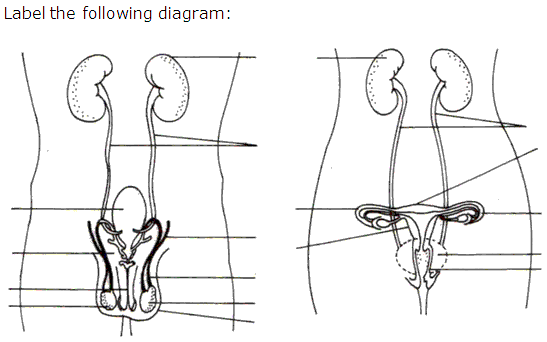
Solution 6
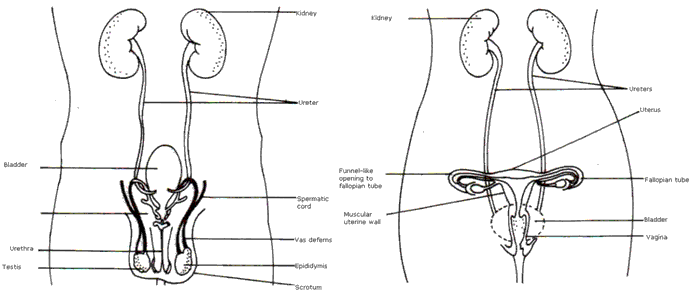
Chapter 11 - Reproductive System Exercise 142
Question 1
Name the following:
(i) The parts of the ovary containing mature ovum.
(ii) Two accessory glands in the male reproductive system.
(iii) The organ of female in which the foetus develops.
(iv) The separation of the foetus from the mother's body.
(v) The part of the female reproductive system in which fertilization occurs.
(i) The parts of the ovary containing mature ovum.
(ii) Two accessory glands in the male reproductive system.
(iii) The organ of female in which the foetus develops.
(iv) The separation of the foetus from the mother's body.
(v) The part of the female reproductive system in which fertilization occurs.
Solution 1
(i) Graafian follicle
(ii) Seminal vesicles and prostate gland
(iii) Uterus
(iv) Parturition
(v) Oviduct
(ii) Seminal vesicles and prostate gland
(iii) Uterus
(iv) Parturition
(v) Oviduct
Question 2
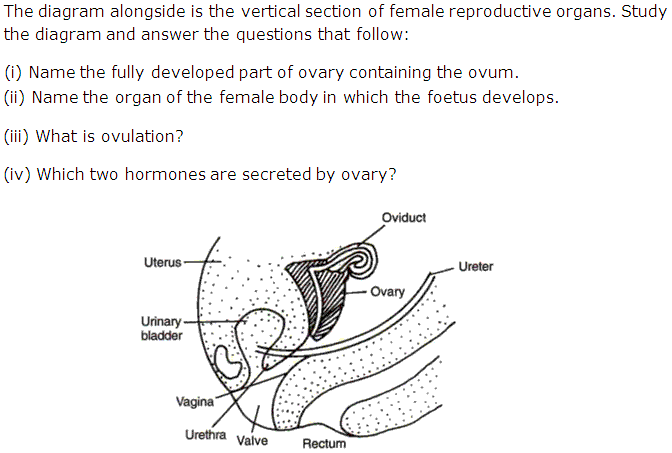
Solution 2
(i) Graafian follicle
(ii) Uterus
(iii) Ovulation is the process of releasing of egg from the ovary.
(iv) The hormones secreted by the ovary are: oestrogen and progesterone.
(ii) Uterus
(iii) Ovulation is the process of releasing of egg from the ovary.
(iv) The hormones secreted by the ovary are: oestrogen and progesterone.
Question 3
Given on the right is a diagram which represents the reproductive organs of a man:
(i) Write the names of the parts numbered 1 to 16.
(ii) Give two functions of the part 6.
(iii) Name three components of the fluid which may be found in the tube labeled 2.
(iv) What is the main function of the part labelled 3?
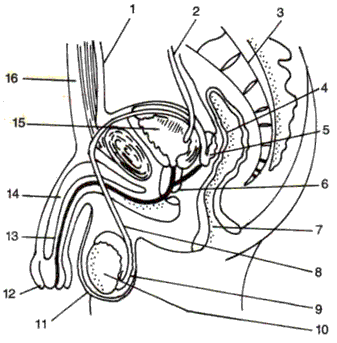
(i) Write the names of the parts numbered 1 to 16.
(ii) Give two functions of the part 6.
(iii) Name three components of the fluid which may be found in the tube labeled 2.
(iv) What is the main function of the part labelled 3?

Solution 3
(i) 1. Peritoneum
2. Ureter
3. Backbone
4. Rectum
5. Seminal vesicle
6. Glands
7. Anus
8. Vas deferens
9. Epididymis
10. Left testis
11. Scrotum
12. Penis
13. Urethra
14. Vascular erectile tissue
15. Bladder
16. Muscular wall of abdomen
(ii) The two functions of part 6 are :
(a) Prostate gland secretes an alkaline milky secretion into semen that aids in sperm motility.
(b) Cowper's gland also secretes a lubricant.
(iii) The three components of urine are urea, uric acid, amino acids, glucose, sodium, potassium, vitamins etc.
(iv) The main function of the part labelled 3 is backbone. Its function is to give support, movement and protection to the spinal cord.
2. Ureter
3. Backbone
4. Rectum
5. Seminal vesicle
6. Glands
7. Anus
8. Vas deferens
9. Epididymis
10. Left testis
11. Scrotum
12. Penis
13. Urethra
14. Vascular erectile tissue
15. Bladder
16. Muscular wall of abdomen
(ii) The two functions of part 6 are :
(a) Prostate gland secretes an alkaline milky secretion into semen that aids in sperm motility.
(b) Cowper's gland also secretes a lubricant.
(iii) The three components of urine are urea, uric acid, amino acids, glucose, sodium, potassium, vitamins etc.
(iv) The main function of the part labelled 3 is backbone. Its function is to give support, movement and protection to the spinal cord.
Question 4
(i) Draw a diagram to display the vertical view of human female reproductive system and label the following parts in the diagram: (1) Ureter (2) Ovary (3) Funnel of fallopian tube (4) Urethra.
(ii) What happens to uterus if fertilization takes place? And what happens to uterus if fertilization does not take place?
(ii) What happens to uterus if fertilization takes place? And what happens to uterus if fertilization does not take place?
Solution 4
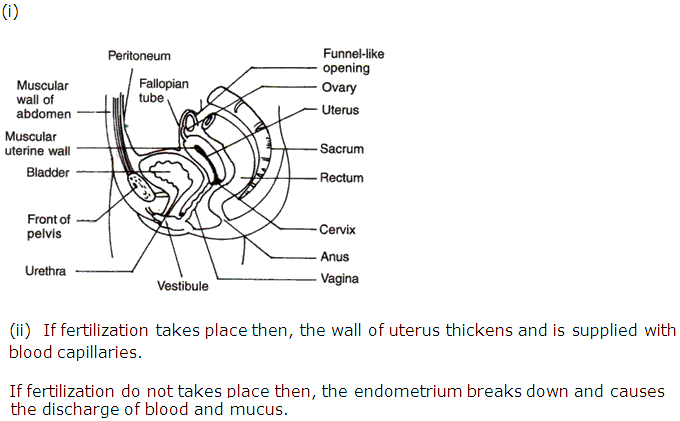
Chapter 11 - Reproductive System Exercise 143
Question 1
Diagram shows the reproductive system of female human beings:
(i) Name the parts numbered 1 to 14.
(ii) Normally, after how many days does an ovary release an egg?
(iii) Where are the sperms released during coitus?
(iv) What is the role of sperms after their ejaculation in vagina?
(v) What is the function of the organ numbered 5?
(vi) What is the gestation period in human?
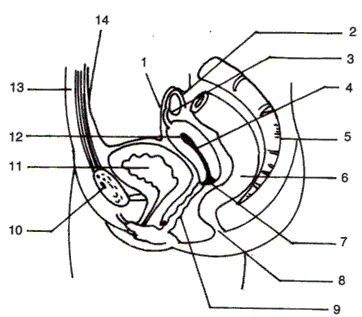
(i) Name the parts numbered 1 to 14.
(ii) Normally, after how many days does an ovary release an egg?
(iii) Where are the sperms released during coitus?
(iv) What is the role of sperms after their ejaculation in vagina?
(v) What is the function of the organ numbered 5?
(vi) What is the gestation period in human?

Solution 1
(i) 1. Fallopian tube
2. Funnel like opening
3. Ovary
4. Uterus
5. Sacrum
6. Rectum
7. Cervix
8. Anus
9. Vagina
10. Front of pelvis
11. Bladder
12. Muscular uterine wall
13. Muscular wall of abdomen
14. Peritoneum
(ii) Normally, after 28 days an ovary releases an egg.
(iii) During coitus, sperm are released in the vagina.
(iv) After ejaculation in vagina, sperms undergo fertilization where it fuses with an ovum of female to form zygote.
(v) The function of sacrum is to protect the pelvic organs or reproductive organs of female.
(vi) The gestation period in human is 280 days.
2. Funnel like opening
3. Ovary
4. Uterus
5. Sacrum
6. Rectum
7. Cervix
8. Anus
9. Vagina
10. Front of pelvis
11. Bladder
12. Muscular uterine wall
13. Muscular wall of abdomen
14. Peritoneum
(ii) Normally, after 28 days an ovary releases an egg.
(iii) During coitus, sperm are released in the vagina.
(iv) After ejaculation in vagina, sperms undergo fertilization where it fuses with an ovum of female to form zygote.
(v) The function of sacrum is to protect the pelvic organs or reproductive organs of female.
(vi) The gestation period in human is 280 days.
Question 2
State whether the following statements are true or false:
(i) Fertilization occurs in the vagina.
(ii) Gestation in humans is completed in about 380 days.
(iii) Oviducts and fallopian tubes are one and the same thing.
(iv) One egg is released from each of the two ovaries every month.
(v) The vagina is a muscular tube.
(i) Fertilization occurs in the vagina.
(ii) Gestation in humans is completed in about 380 days.
(iii) Oviducts and fallopian tubes are one and the same thing.
(iv) One egg is released from each of the two ovaries every month.
(v) The vagina is a muscular tube.
Solution 2
(i) False
(ii) False
(iii) True
(iv) False
(v) True
(ii) False
(iii) True
(iv) False
(v) True
Question 3
Rewrite the correct statement by changing the last one word if these statements are false.
Pregnancy in women can be prevented by the method of vasectomy. (True/False)
Pregnancy in women can be prevented by the method of vasectomy. (True/False)
Solution 3
False.
Pregnancy in women can be prevented by the method of tubectomy.
Pregnancy in women can be prevented by the method of tubectomy.
Question 4
Name the membrane that surrounds the foetus and secretes a protective fluid.
Solution 4
Amnion.
Question 5
Give appropriate terms for each of the following:
(i) The onset of reproductive phase in a young female.
(ii) The rupture of follicle and release of ovum from the ovary.
(iii) The monthly discharge of blood and disintegrated uterine tissues in human female.
(iv) The process of fusion of ovum and sperm.
(v) The attachment of developing zygote (blastocyst) on the uterine wall.
(i) The onset of reproductive phase in a young female.
(ii) The rupture of follicle and release of ovum from the ovary.
(iii) The monthly discharge of blood and disintegrated uterine tissues in human female.
(iv) The process of fusion of ovum and sperm.
(v) The attachment of developing zygote (blastocyst) on the uterine wall.
Solution 5
(i) Menarche
(ii) Ovulation
(iii) Menstruation
(iv) Fertilization
(v) Implantation
(ii) Ovulation
(iii) Menstruation
(iv) Fertilization
(v) Implantation
Question 6
Choose the correct answer:
(i) The aim of sexual reproduction
(a) over production (b) continuity of race
(c) low production (d) none
(ii) Binary fission is a method of
(a) parthenogenesis (b) asexual reproduction.
(c) sexual reproduction (d) none
(iii) Ovum is a
(a) male gamete (b) female gamete
(c) a chemical (d) a fibre
(iv) Virgin birth is called
(a) Sexual Reproduction (b) Asexual Reproduction
(c) Parthenogenesis (d) Abiogenesis
(v) Cervix is a part of
(a) ovary (b) vagina
(c) uterus (d) oviduct
(vi) Removal of testes is called
(a) regeneration (b) reproduction
(c) castration(d) none
(vii) Fertilization occurs in
(a) uterus (b) oviduct
(c) ovary (d) vagina
(viii) Secondary sexual characters appear in
(a) foetus (b) childhood
(c) puberty (d) adulthood
(ix) The onset of menstruation in the female is termed
(a) ovulation (b) menarche
(c) menopause (d) parthenogenesis
(x) Temperature of scrotum is
(a)20C above body temperature (b) same as body temperature
(c) 20-30C below the body temperature (d) none of the above
(xi) First menstrual cycle is known as
(a) menopause (b) amenorrhoea
(c) puberty (d) Menarche
(xii) When pregnancy does not occur, the life of corpus luteum is about
(a) 4 days (b) 10 days
(c) 14 days (d) 28 days
(i) The aim of sexual reproduction
(a) over production (b) continuity of race
(c) low production (d) none
(ii) Binary fission is a method of
(a) parthenogenesis (b) asexual reproduction.
(c) sexual reproduction (d) none
(iii) Ovum is a
(a) male gamete (b) female gamete
(c) a chemical (d) a fibre
(iv) Virgin birth is called
(a) Sexual Reproduction (b) Asexual Reproduction
(c) Parthenogenesis (d) Abiogenesis
(v) Cervix is a part of
(a) ovary (b) vagina
(c) uterus (d) oviduct
(vi) Removal of testes is called
(a) regeneration (b) reproduction
(c) castration(d) none
(vii) Fertilization occurs in
(a) uterus (b) oviduct
(c) ovary (d) vagina
(viii) Secondary sexual characters appear in
(a) foetus (b) childhood
(c) puberty (d) adulthood
(ix) The onset of menstruation in the female is termed
(a) ovulation (b) menarche
(c) menopause (d) parthenogenesis
(x) Temperature of scrotum is
(a)20C above body temperature (b) same as body temperature
(c) 20-30C below the body temperature (d) none of the above
(xi) First menstrual cycle is known as
(a) menopause (b) amenorrhoea
(c) puberty (d) Menarche
(xii) When pregnancy does not occur, the life of corpus luteum is about
(a) 4 days (b) 10 days
(c) 14 days (d) 28 days
Solution 6
(i) (b) continuity of race
(ii) (b) asexual reproduction
(iii) (b) female gamete
(iv) (c) Parthenogenesis
(v) (b) vagina
(vi) (c ) castration
(vii) (b) oviduct
(viii) (c ) puberty
(ix) (b) menarche
(x) (c ) 20-30C below the body temperature
(xi) (d) menarche
(xii) (b) 10 days
(ii) (b) asexual reproduction
(iii) (b) female gamete
(iv) (c) Parthenogenesis
(v) (b) vagina
(vi) (c ) castration
(vii) (b) oviduct
(viii) (c ) puberty
(ix) (b) menarche
(x) (c ) 20-30C below the body temperature
(xi) (d) menarche
(xii) (b) 10 days

0 comments:
Post a Comment